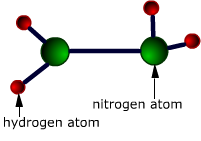hydrazine

Hydrazine (N2H4) is a clear, fuming, corrosive, highly toxic covalent hydride with a fishy smell. It is obtained by the reaction between chloramine (NH2Cl) and ammonia (NH3), and can also be prepared by oxidizing urea with hypochlorite in the presence of gelatin.
Hydrazine is used as a liquid rocket fuel, both as a monopropellant, especially in attitude control thrusters, and as a bipropellant. As a monopropellant in catalytic decomposition engines, it is ignited by passing it over a heated catalyst (alumina pellets impregnated with iridium) that decomposes the fuel and produces ammonia, nitrogen, and hydrogen exhaust gases. The decomposition of hydrazine produces temperatures of about 925°C (1,700°F) and a specific impulse of 230–240 seconds. As a bipropellant it is also a hypergolic propellant used, for example, in the second stage of the Titan family of launch vehicles in a 50% hydrazine / 50% UDMH mixture known as Aerozine 50.
Hydrazine is also used as a corrosion inhibitor in boilers, to cure rubber, and in the production of plastics, explosives, and fungicides.
General chemistry
Hydrazine is prepared by the Raschig synthesis in which ammonia reacts with sodium (I) chlorate to give NH2Cl, which then undergoes further reduction with ammonia to give N2H4. It is very soluble in water and soluble in ethanol. Hydrazine is a weak base giving to two series of salts, those based on N2H5+, which are stable in water, and a less stable and extensively hydrolyzed based on N2H52+. It reacts with aldehydes and ketones to give hydrazones (RCH=NNH2).
| relative density | 1.011 (liquid) |
| melting point | 1.4°C (34.5°F) |
| boiling point | 113.5°C (236.3°F) |


